climate control JEEP COMMANDER 2009 1.G User Guide
[x] Cancel search | Manufacturer: JEEP, Model Year: 2009, Model line: COMMANDER, Model: JEEP COMMANDER 2009 1.GPages: 519, PDF Size: 9.78 MB
Page 278 of 519
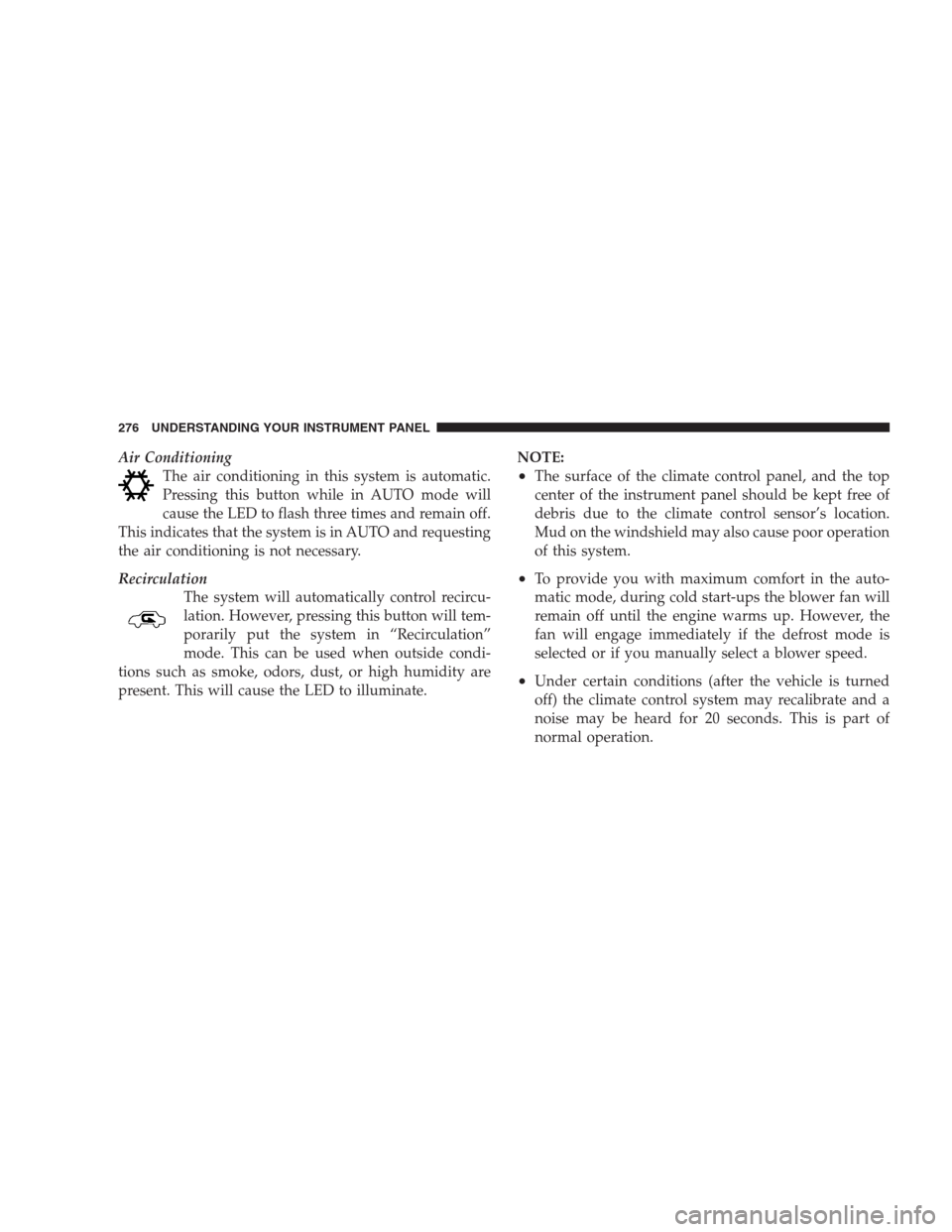
Air Conditioning
The air conditioning in this system is automatic.
Pressing this button while in AUTO mode will
cause the LED to flash three times and remain off.
This indicates that the system is in AUTO and requesting
the air conditioning is not necessary.
Recirculation
The system will automatically control recircu-
lation. However, pressing this button will tem-
porarily put the system in “Recirculation”
mode. This can be used when outside condi-
tions such as smoke, odors, dust, or high humidity are
present. This will cause the LED to illuminate.NOTE:
•The surface of the climate control panel, and the top
center of the instrument panel should be kept free of
debris due to the climate control sensor’s location.
Mud on the windshield may also cause poor operation
of this system.
•To provide you with maximum comfort in the auto-
matic mode, during cold start-ups the blower fan will
remain off until the engine warms up. However, the
fan will engage immediately if the defrost mode is
selected or if you manually select a blower speed.
•Under certain conditions (after the vehicle is turned
off) the climate control system may recalibrate and a
noise may be heard for 20 seconds. This is part of
normal operation.
276 UNDERSTANDING YOUR INSTRUMENT PANEL
Page 283 of 519
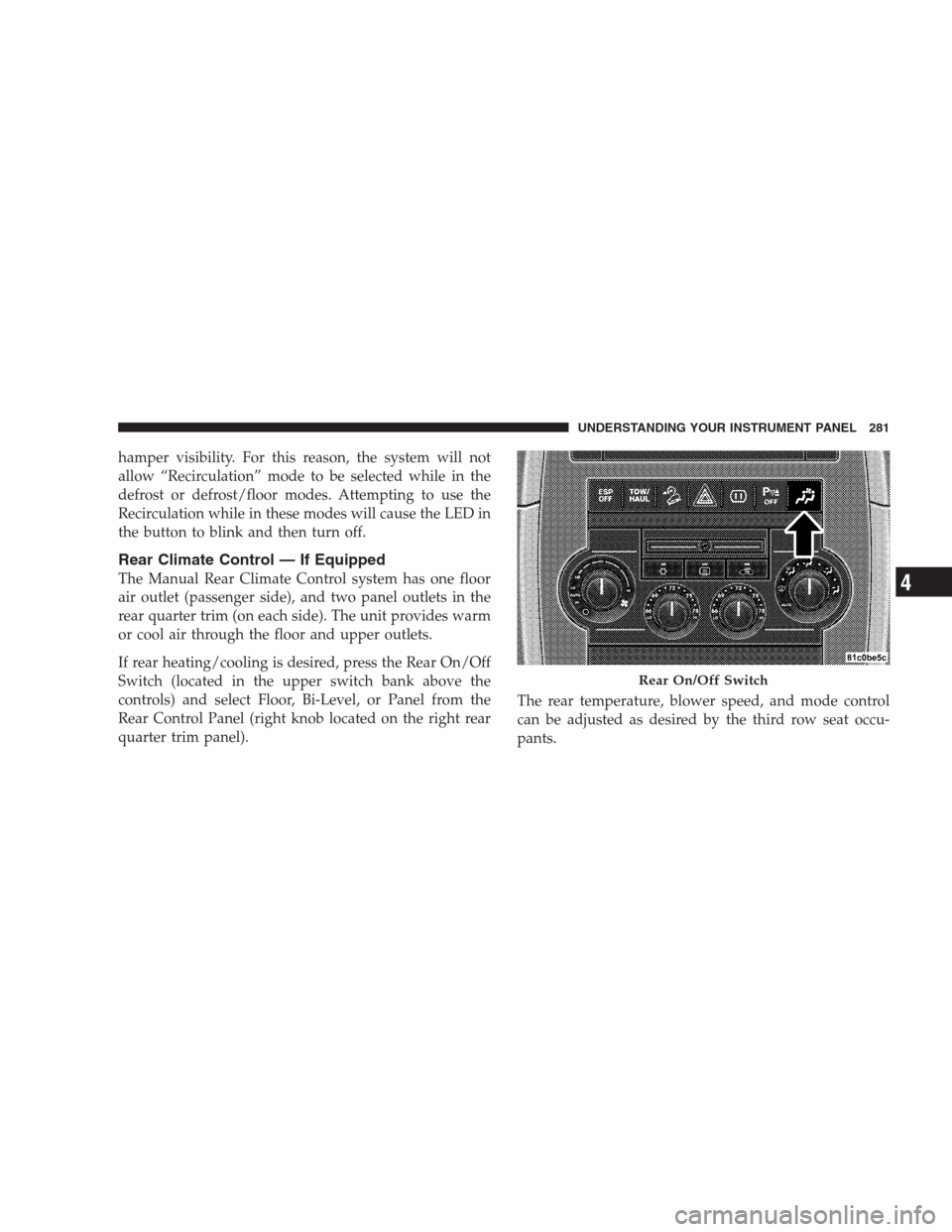
hamper visibility. For this reason, the system will not
allow “Recirculation” mode to be selected while in the
defrost or defrost/floor modes. Attempting to use the
Recirculation while in these modes will cause the LED in
the button to blink and then turn off.
Rear Climate Control — If Equipped
The Manual Rear Climate Control system has one floor
air outlet (passenger side), and two panel outlets in the
rear quarter trim (on each side). The unit provides warm
or cool air through the floor and upper outlets.
If rear heating/cooling is desired, press the Rear On/Off
Switch (located in the upper switch bank above the
controls) and select Floor, Bi-Level, or Panel from the
Rear Control Panel (right knob located on the right rear
quarter trim panel).The rear temperature, blower speed, and mode control
can be adjusted as desired by the third row seat occu-
pants.
Rear On/Off Switch
UNDERSTANDING YOUR INSTRUMENT PANEL 281
4
Page 284 of 519
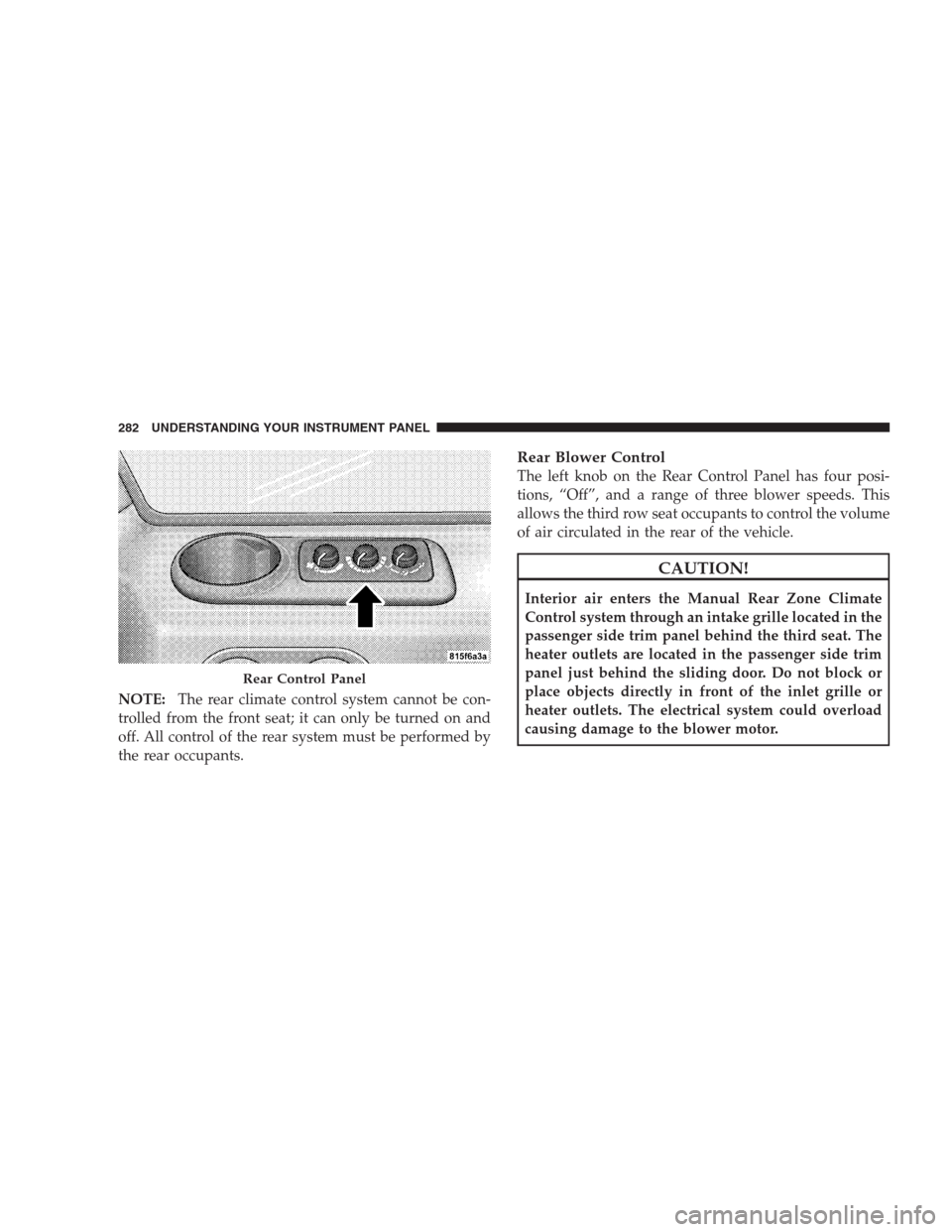
NOTE:The rear climate control system cannot be con-
trolled from the front seat; it can only be turned on and
off. All control of the rear system must be performed by
the rear occupants.
Rear Blower Control
The left knob on the Rear Control Panel has four posi-
tions, “Off”, and a range of three blower speeds. This
allows the third row seat occupants to control the volume
of air circulated in the rear of the vehicle.
CAUTION!
Interior air enters the Manual Rear Zone Climate
Control system through an intake grille located in the
passenger side trim panel behind the third seat. The
heater outlets are located in the passenger side trim
panel just behind the sliding door. Do not block or
place objects directly in front of the inlet grille or
heater outlets. The electrical system could overload
causing damage to the blower motor.
Rear Control Panel
282 UNDERSTANDING YOUR INSTRUMENT PANEL
Page 402 of 519
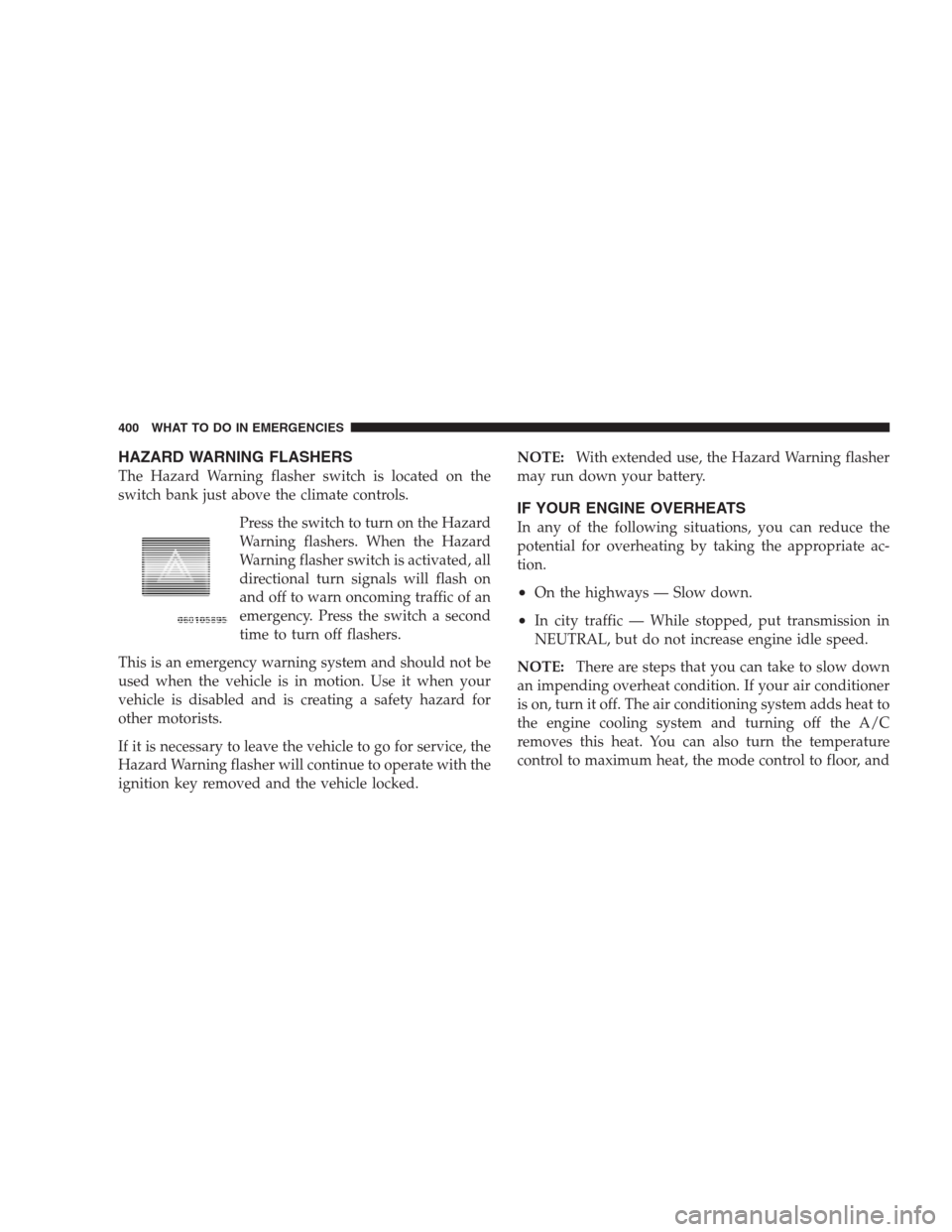
HAZARD WARNING FLASHERS
The Hazard Warning flasher switch is located on the
switch bank just above the climate controls.
Press the switch to turn on the Hazard
Warning flashers. When the Hazard
Warning flasher switch is activated, all
directional turn signals will flash on
and off to warn oncoming traffic of an
emergency. Press the switch a second
time to turn off flashers.
This is an emergency warning system and should not be
used when the vehicle is in motion. Use it when your
vehicle is disabled and is creating a safety hazard for
other motorists.
If it is necessary to leave the vehicle to go for service, the
Hazard Warning flasher will continue to operate with the
ignition key removed and the vehicle locked.NOTE:With extended use, the Hazard Warning flasher
may run down your battery.
IF YOUR ENGINE OVERHEATS
In any of the following situations, you can reduce the
potential for overheating by taking the appropriate ac-
tion.
•On the highways — Slow down.
•In city traffic — While stopped, put transmission in
NEUTRAL, but do not increase engine idle speed.
NOTE:There are steps that you can take to slow down
an impending overheat condition. If your air conditioner
is on, turn it off. The air conditioning system adds heat to
the engine cooling system and turning off the A/C
removes this heat. You can also turn the temperature
control to maximum heat, the mode control to floor, and
400 WHAT TO DO IN EMERGENCIES
Page 495 of 519
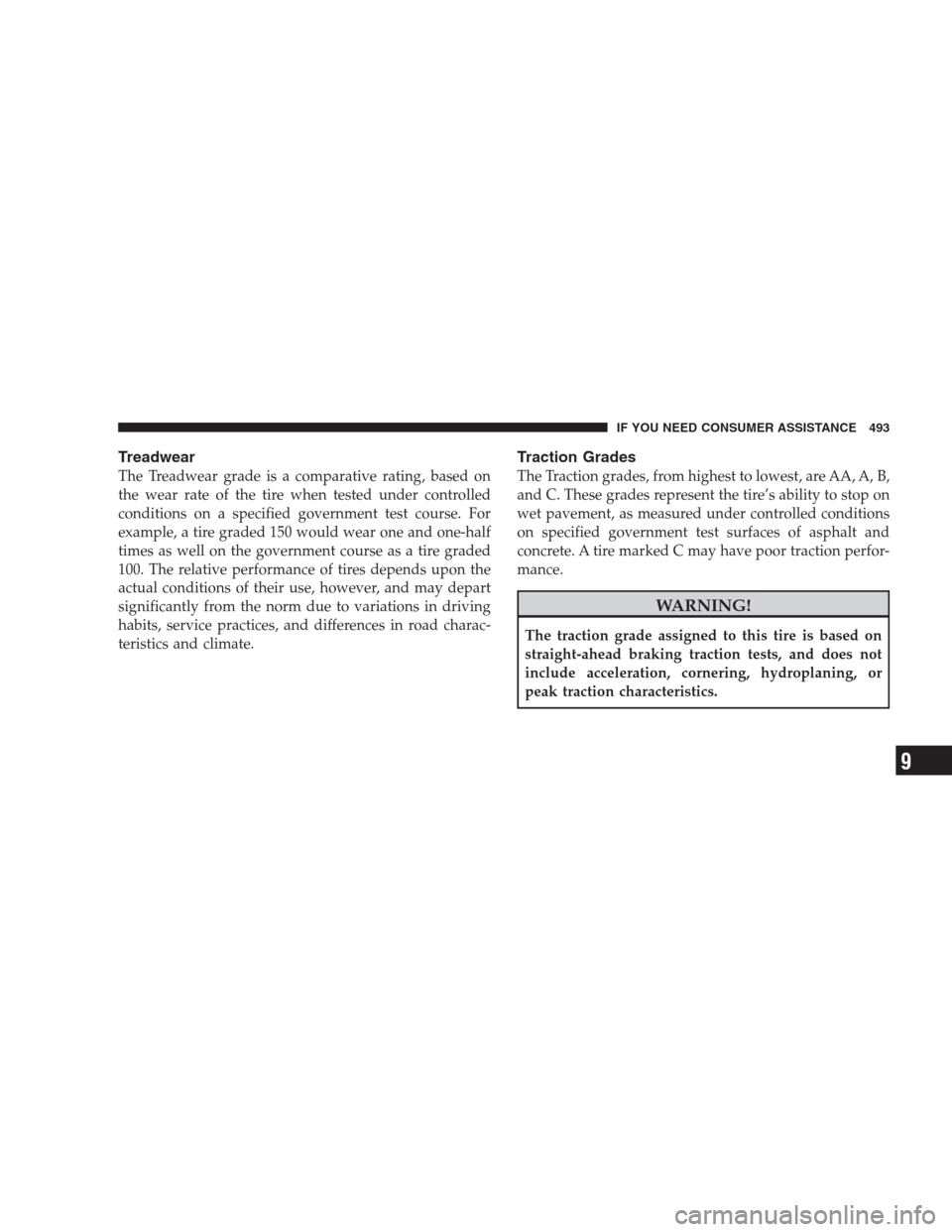
Treadwear
The Treadwear grade is a comparative rating, based on
the wear rate of the tire when tested under controlled
conditions on a specified government test course. For
example, a tire graded 150 would wear one and one-half
times as well on the government course as a tire graded
100. The relative performance of tires depends upon the
actual conditions of their use, however, and may depart
significantly from the norm due to variations in driving
habits, service practices, and differences in road charac-
teristics and climate.
Traction Grades
The Traction grades, from highest to lowest, are AA, A, B,
and C. These grades represent the tire’s ability to stop on
wet pavement, as measured under controlled conditions
on specified government test surfaces of asphalt and
concrete. A tire marked C may have poor traction perfor-
mance.
WARNING!
The traction grade assigned to this tire is based on
straight-ahead braking traction tests, and does not
include acceleration, cornering, hydroplaning, or
peak traction characteristics.
IF YOU NEED CONSUMER ASSISTANCE 493
9
Page 500 of 519
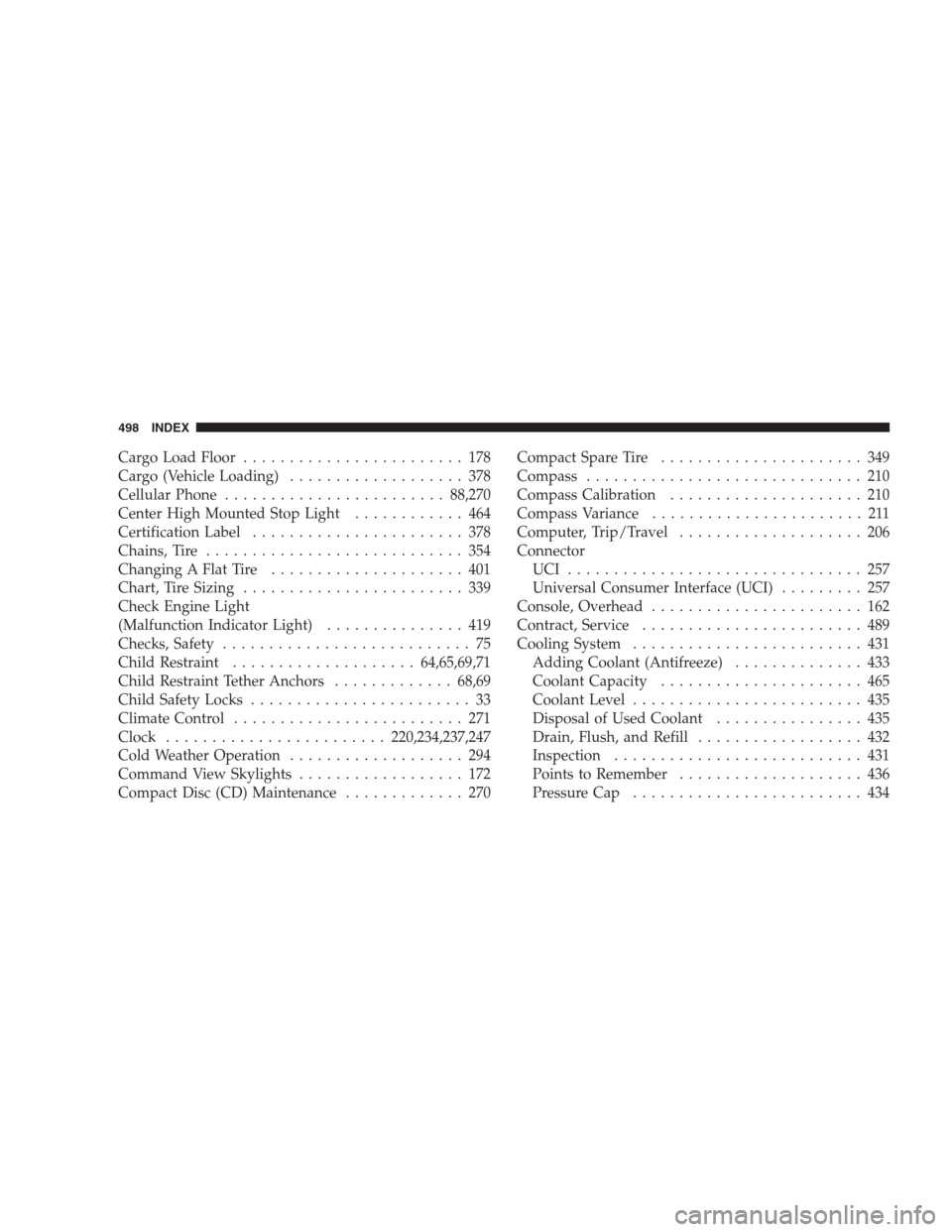
Cargo Load Floor........................ 178
Cargo (Vehicle Loading)................... 378
Cellular Phone........................88,270
Center High Mounted Stop Light............ 464
Certification Label....................... 378
Chains, Tire............................ 354
Changing A Flat Tire..................... 401
Chart, Tire Sizing........................ 339
Check Engine Light
(Malfunction Indicator Light)............... 419
Checks, Safety........................... 75
Child Restraint....................64,65,69,71
Child Restraint Tether Anchors.............68,69
Child Safety Locks........................ 33
Climate Control......................... 271
Clock........................220,234,237,247
Cold Weather Operation................... 294
Command View Skylights.................. 172
Compact Disc (CD) Maintenance............. 270Compact Spare Tire...................... 349
Compass.............................. 210
Compass Calibration..................... 210
Compass Variance....................... 211
Computer, Trip/Travel.................... 206
Connector
UCI ................................ 257
Universal Consumer Interface (UCI)......... 257
Console, Overhead....................... 162
Contract, Service........................ 489
Cooling System......................... 431
Adding Coolant (Antifreeze).............. 433
Coolant Capacity...................... 465
Coolant Level......................... 435
Disposal of Used Coolant................ 435
Drain, Flush, and Refill.................. 432
Inspection........................... 431
Points to Remember.................... 436
Pressure Cap......................... 434
498 INDEX